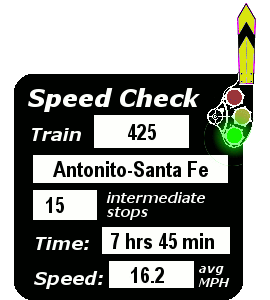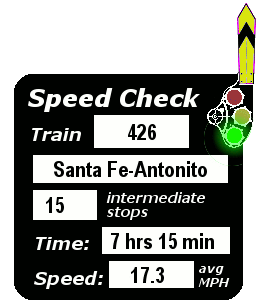From
the pages of
the
Official Guide, June 1941

The Chili Line
Denver
& Rio Grande Western RR
June 16, 1940
| 15 |
Connecting Train Number |
16 |
|
7 30P |
Dp |
0.0 |
Denver, CO (MT) |
T C |
Ar |
7 15A |
|
11 25P |
|
119.1 |
Pueblo, CO |
T C |
|
3 50A |
| M 4 30A |
Ar |
246.9 |
Alamosa, CO |
M |
Dp |
9
40P |
| 115 |
Connecting Train Number |
116 |
| 7 00A |
Dp |
246.9 |
Alamosa, CO |
M |
Ar |
M
8 30P |
| 8 05A |
Ar |
275.5 |
Antonito, CO |
T C |
Dp |
7
25P |
| 425 |
Train
Number |
426 |
| Ex Su |
|
Miles |
(Narrow
Gauge Lines) |
Services |
|
Ex Su |
| 8 15A |
Dp |
275.5 |
Antonito, CO (MT) |
T C |
Ar |
5 15P |
| F 8 50A |
|
287.0 |
Palmilla, NM |
|
|
F 4 37P |
| F 9 12A |
|
293.9 |
Volcano, NM |
|
|
F 4 11P |
| F 9 40A |
|
303.1 |
No Agua, NM |
|
|
F 3 38P |
| 10 05A |
|
310.2 |
Tres Piedras, NM |
T |
|
3 14P |
| 10 40A |
|
319.9 |
Servilleta, NM |
T |
|
2 41P |
| 11 30A |
|
331.7 |
Taos Junction, NM |
|
|
2 02P |
|
12 01P |
|
340.3 |
Barranca, NM |
|
|
F 1 25P |
|
12 45P |
|
347.8 |
Embudo, NM |
T |
|
12 45P |
|
F 1 14P |
|
355.8 |
Claro, NM |
|
|
F12 19P |
|
F 1 36P |
|
362.0 |
Chamita, NM |
|
|
F12 01P |
|
2 00P |
|
366.8 |
Espanola, NM |
T C |
|
11 46A |
|
F 2 23P |
|
373.8 |
San Ildefonso, NM |
|
|
F11 16A |
|
F 2 29P |
|
375.8 |
Otowi, NM |
|
|
F11 11A |
|
F 2 42P |
|
379.3 |
Buckman, NM |
|
|
F11 00A |
|
F 3 17P |
|
389.0 |
Jacona, NM |
|
|
F10 32A |
|
4 00P |
Ar |
401.1 |
Santa Fe, NM (MT) |
T C |
Dp |
10 00A |


Trains 425 and 426
are mixed
passenger and freight trains.









General William Palmer's dream had been for his Denver & Rio Grande to grow into a narrow-gauge system stretching from Denver to Mexico City. The line south from Alamosa to Santa Fe was a stepping stone on the way to realizing that dream—but after the loss of Raton Pass to and the conflict at Royal Gorge with the Santa Fe, and the subsequent "Treaty of Boston" which effectively ceded northern New Mexico to the ATSF, the Rio Grande turned its attention to the rich mining territory in western Colorado, with the intended line to Santa Fe terminated at Espanola.
It took a third party to step in and complete the line the DRG had originally planned. After several financial reversals, the Texas, Santa Fe & Northern railroad company completed the line from Santa Fe to Espanola in January 1887. After a few more years the Denver & Rio Grande obtained control and the completed line officially became the Santa Fe Branch. Unofficially, though—well, with the sparse freight traffic on the line, one cargo that was worthy of notice and consistent enough to be depended upon was the chili peppers which were grown by the farmers along the line. Hence the Santa Fe Branch is better known to history as the "Chili Line".